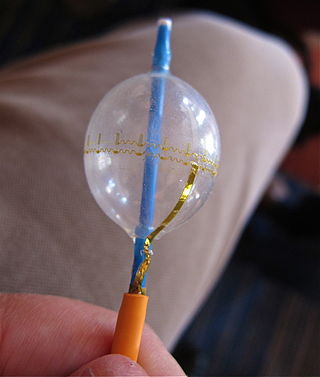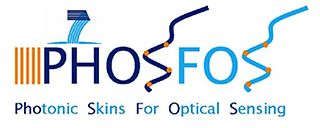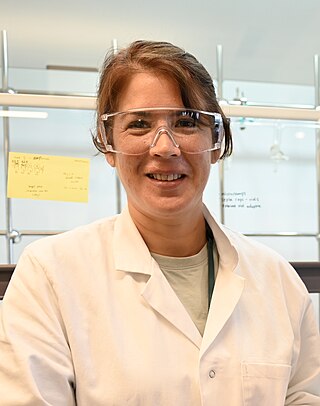
Organic electronics is a field of materials science concerning the design, synthesis, characterization, and application of organic molecules or polymers that show desirable electronic properties such as conductivity. Unlike conventional inorganic conductors and semiconductors, organic electronic materials are constructed from organic (carbon-based) molecules or polymers using synthetic strategies developed in the context of organic chemistry and polymer chemistry.

Flexible electronics, also known as flex circuits, is a technology for assembling electronic circuits by mounting electronic devices on flexible plastic substrates, such as polyimide, PEEK or transparent conductive polyester film. Additionally, flex circuits can be screen printed silver circuits on polyester. Flexible electronic assemblies may be manufactured using identical components used for rigid printed circuit boards, allowing the board to conform to a desired shape, or to flex during its use.

Printed electronics is a set of printing methods used to create electrical devices on various substrates. Printing typically uses common printing equipment suitable for defining patterns on material, such as screen printing, flexography, gravure, offset lithography, and inkjet. By electronic-industry standards, these are low-cost processes. Electrically functional electronic or optical inks are deposited on the substrate, creating active or passive devices, such as thin film transistors; capacitors; coils; resistors. Some researchers expect printed electronics to facilitate widespread, very low-cost, low-performance electronics for applications such as flexible displays, smart labels, decorative and animated posters, and active clothing that do not require high performance.

Stretchable electronics, also known as elastic electronics or elastic circuits, is a group of technologies for building electronic circuits by depositing or embedding electronic devices and circuits onto stretchable substrates such as silicones or polyurethanes, to make a completed circuit that can experience large strains without failure. In the simplest case, stretchable electronics can be made by using the same components used for rigid printed circuit boards, with the rigid substrate cut to enable in-plane stretchability. However, many researchers have also sought intrinsically stretchable conductors, such as liquid metals.

Electronic textiles or e-textiles are fabrics that enable electronic components such as batteries, lights, sensors, and microcontrollers to be embedded in them. They are not to be confused with smart textiles, which are fabrics that have been developed with new technologies that provide added value. Many smart clothing, wearable technology, and wearable computing projects involve the use of e-textiles.
A light-emitting electrochemical cell is a solid-state device that generates light from an electric current (electroluminescence). LECs are usually composed of two metal electrodes connected by an organic semiconductor containing mobile ions. Aside from the mobile ions, their structure is very similar to that of an organic light-emitting diode (OLED).

PhoSFOS is a research and technology development project co-funded by the European Commission.
Ensurge Micropower ASA is a Norwegian microbattery manufacturing company with global headquarters, R&D offices, and flexible electronics manufacturing in San Jose, California, United States and corporate headquarters in Oslo. Ensurge designs, develops, and produces solid-state lithium battery (SSLB) products using roll-to-roll printing technology on stainless steel substrates.

Zhenan Bao is a chemical engineer. She serves as K. K. Lee Professor of Chemical Engineering at Stanford University, with courtesy appointments in Chemistry and Material Science and Engineering. She served as the Department Chair of Chemical Engineering from 2018 to 2022. Bao is known for her work on organic field-effect transistors and organic semiconductors, for applications including flexible electronics and electronic skin.

Richard Stephen Muller is an American professor in the Electrical Engineering and Computer Science Department of the University of California at Berkeley.
Electronic skin refers to flexible, stretchable and self-healing electronics that are able to mimic functionalities of human or animal skin. The broad class of materials often contain sensing abilities that are intended to reproduce the capabilities of human skin to respond to environmental factors such as changes in heat and pressure.

Flexible batteries are batteries, both primary and secondary, that are designed to be conformal and flexible, unlike traditional rigid ones. They can maintain their characteristic shape even against continual bending or twisting. The increasing interest in portable and flexible electronics has led to the development of flexible batteries which can be implemented in products such as smart cards, wearable electronics, novelty packaging, flexible displays and transdermal drug delivery patches. The advantages of flexible batteries are their conformability, light weight, and portability, which makes them easy to be implemented in products such as flexible and wearable electronics. Hence efforts are underway to make different flexible power sources including primary and rechargeable batteries with high energy density and good flexibility.
A conductive elastomer is a form of elastomer, often natural rubber or other rubber substitute, that is manufactured to conduct electricity. This is commonly accomplished by distributing carbon or other conductive particles throughout the raw material prior to setting it. Carbon black and silica are common additives to induce conductivity in elastomers. Silica has been studied more so than other additives due to its low cost however, its conductance is also lower. These additives can not only enable conductance but can increase the mechanical properties of the elastomer.

Soft robotics is a subfield of robotics that concerns the design, control, and fabrication of robots composed of compliant materials, instead of rigid links. In contrast to rigid-bodied robots built from metals, ceramics and hard plastics, the compliance of soft robots can improve their safety when working in close contact with humans.
Albert P. Pisano is an American academic. He serves as dean of the Jacobs School of Engineering at the University of California San Diego, a position he has held since September 2013. Pisano publishes a monthly Dean's column that introduces the monthly news email from the UC San Diego Jacobs School of Engineering. The January 2022 dean's column, "Math matters to all of us" triggered significant conversation on Pisano's LinkedIn feed.

Azita Emami-Neyestanak is the Andrew and Peggy Cherng Professor of Electrical Engineering and Medical Engineering at Caltech. Emami works on low-power mixed-mode circuits in scalable technologies. She is Executive Officer of the Department of Electrical Engineering and an investigator in the Heritage Medical Research Institute.

A foldable smartphone is a smartphone with a folding form factor. It is reminiscent of the clamshell design of many earlier feature phones. Some variants of the concept use multiple touchscreen panels on a hinge, while other designs utilise a flexible display. Concepts of such devices date back as early as Nokia's "Morph" concept in 2008, and a concept presented by Samsung Electronics in 2013, while the first commercially available folding smartphones with OLED displays began to emerge in November 2018.
Tricia L. Carmichael is a Professor in the Department of Chemistry and Biochemistry at the University of Windsor. She develops new materials for stretchable electronics with a current focus on wearable electronic devices.
Roya Maboudian is an American academic and researcher in the field of chemical engineering. She is professor of chemical and biomolecular engineering at the University of California, Berkeley. She is a co-director of the Berkeley Sensor and Actuator Center, and an editor of the IEEE Journal of Microelectromechanical Systems. She was one of the first women to earn tenure in the chemical engineering department at the University of California, Berkeley.

Christine Luscombe is a Japanese-British chemist who is a professor at the Okinawa Institute of Science and Technology. Her research investigates polymer chemistry, organic electronics, organic photovoltaics and the synthesis of novel materials for processable electronics. She serves on the editorial boards of Macromolecules, Advanced Functional Materials, the Annual Review of Materials Research and ACS Applied Materials & Interfaces.













